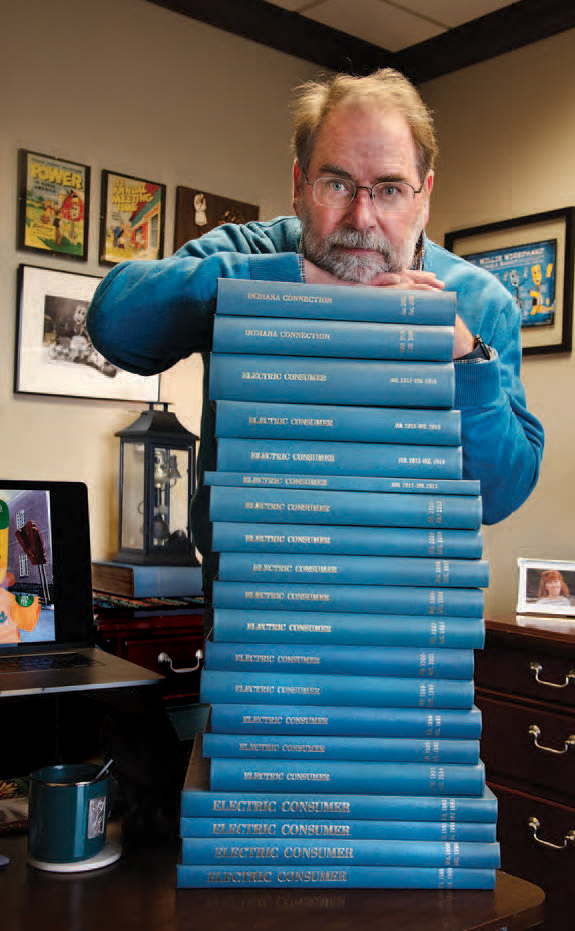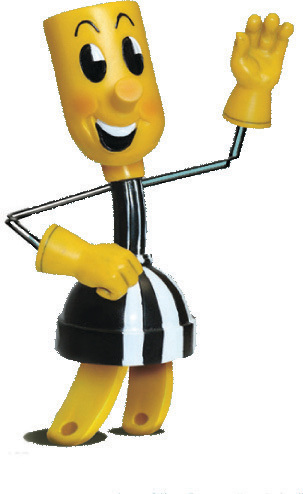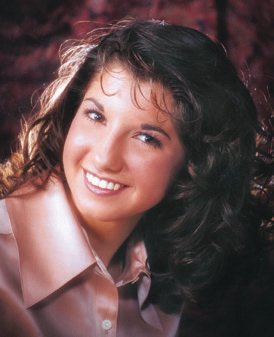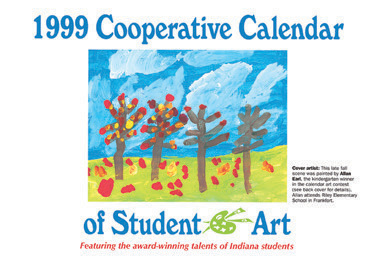By Richard Biever

“Don’t look back,” legendary baseball pitcher Satchel Paige used to advise. “Something might be gaining on you.” For most of us, that something is time. But in our headlong rush around life’s bases, a glance over the shoulder is sometimes appropriate. This is mine.
This is my final issue as senior editor of Indiana Connection. After 35 years and two months, 422 monthly issues, I will be retired by the time this lands in mailboxes in March. My final day was Feb. 2, Groundhog Day.
I hope I won’t be waking every morning to “I Got You, Babe,” the Sonny and Cher oldie that awakened Bill Murray every day in the movie “Groundhog Day,” as he was stuck reliving the same day, over and over again. But, I do hope to work on improving myself a little each day as Murray’s character ended up doing with his daily do-overs.
Before pressing on to a new chapter, I’ve looked back on the past pages. In my (now old) office are two shelves holding all the bound volumes of this publication. The top row is all the issues from when it began in July 1951 to December 1988. It was originally called Indiana Rural News, then Electric Consumer. The bottom shelf picks up with January 1989, when I arrived, and runs to present as Indiana Connection. Over the past months, I found myself running my fingers across the books on the second shelf. Occasionally, I’ve pulled one out and wistfully thumbed through the pages. Reading stories I’d written when I was half my current age spun me back down the years — the way an old song does when it pops up on the radio. I recall the details and the people of that story — and that time and place in my life, as well. I’ve dog-eared many of these pages and memories in my mind.
The first story I worked on was for the February 1989 issue. I visited the edges of a coal mine in northern Daviess County on a misty, cold, gray January day. An entrepreneur, who was apparently part alchemist, set up a small-scale operation there that removed sulfur from coal using dry-cleaning fluid and old equipment from a chocolate factory he bought at auction. Though it sounded a little far-fetched, his efforts to take it utility scale were backed by groups in the electric and coal industries. Back then, burning high-sulfur coal was linked to acid rain falling on the Northeast U.S. and Canada. If this cleaning process could keep Indiana’s high-sulfur coal viable and reduce acid rain, this was big. For a 27-year-old guy coming from a suburban Indianapolis newspaper — where covering interstate fatalities and murderers for four years had worn me thin — this was fulfilling and fascinating stuff.
Oy, how things changed in 35 years. Acid rain was solved in part by utilities and an act of Congress, but it was a sprinkle compared to global climate change linked to greenhouse gases that has dominated the electric industry since. Over the years, I’ve written about these concerns and the new technologies — wind and solar farms — that are cleaner, albeit less reliable, than fossil fuels. I’ve written about new considerations of nuclear power, development of hydrogen fuel cells and capturing waste gases from landfills and large dairy farms to generate electricity. And I’ve written about the co-op programs promoting energy efficiency and home construction techniques that reduce a home’s carbon footprint, save consumers money and make their homes more comfortable. That’s a feel-good story for everybody.
While energy topics were always important, I’ve written about other rural issues like healthcare, economic opportunities and the devastation caused by the scourge of methamphetamine. But my favorite stories have been the softer features about co-op consumers and Indiana.
I’ve loved writing about Indiana’s connections to: Abraham Lincoln; Gus Grissom; “Old Ironsides” (the U.S.S. Constitution), whose new white oak timbers come from the woods at Crane Naval base; and baseball Hall of Famers Gil Hodges and Hank Aaron. I loved covering the school kids and teacher who successfully lobbied for the firefly as the state insect; and state DNR officials who let me tag along as they banded baby bald eagles and barn owls.
I’ve loved the stories and photos I’ve gathered: from the Indiana Dunes National Park and the state parks; from the banks of the Wabash and Ohio rivers to the scenic highways and bicycle trails; and from venturing deep into Indiana’s commercial caves, voyaging across the night sky with Indiana’s astronomical societies, and looking at the sun with this month’s cover story.
We often asked readers to write the cover story for us in the form of short recollections. Topics have included holiday traditions and memories, World War II, the JFK assassination, the Beatles at the state fair, 9/11 and the joy of living in rural Indiana. And from 1996–2005, we asked readers to illustrate the December cover story, too, with a Christmas tree ornament contest. It was always my pleasure to edit the written memories, photograph the hand-crafted ornaments and then present those pages.
The ornament contest introduced me to Maria Fedyniak, a consumer who created intricate, traditional pysanky eggs she learned to make as a little girl in her native Ukraine. She became a dear friend who patiently tried to teach my wife, Beth, our children and me the skill. And in these pages, I even had a chance to share the personal story of our two children, now both 26 years old, who Beth and I adopted as babies from a Russian orphanage near Ukraine.
One of my favorite scenes from my favorite baseball movie, “The Natural,” has Robert Redford as the mythical Roy Hobbs pondering the probability his playing days are done. He looks up from a hospital bed to the love of his life, played by Glenn Close, and earnestly sighs, “God, I love baseball.” I feel the same way about the career electric co-ops and you all reading this have given me. I’m going to miss being a part of all this. This is going to sound sappy, but it’s sincere, when I say: God, I love co-ops. And I’ve loved sharing these stories and these pages with you.
Richard Biever is the retired senior editor of Indiana Connection.
Memorable markers
After 35+ years, 422 issues of the monthly publication, it would be impossible to list all my favorite stories, or even a smidgen of them and not leave out dozens. My “favorite story” always felt like the one I was working on at the time. But some of the most memorable stories or projects include:
WILLIE WIREDHAND: ICON IN THE ‘PANTHEON OF SPOKESPLUGS’

Mascot Willie Wiredhand has been connecting electric co-ops to consumers since the 1950s. Enthusiastically, I jumped on Willie’s bandwagon when I came aboard. Willie proved he could still endear himself to new generations teaching electrical safety, efficiency and even geography. He’s helped illustrate many of the stories I’ve written over the years. All the friendly folks we know at our local co-op eventually will retire. But Willie’s friendly shining visage will live on.
BRINGING OUR LIGHT TO RURAL GUATEMALA

Spending three weeks with a group of linemen as they constructed the power lines and wired the huts to electrify a a poor village in rural Guatemala in the spring of 2019 was unforgettable. Basking in this “National Geographic” photographer opportunity, I was never more proud of the people and the organization with and for whom I work.
VALERIE JAMES: A FOREVER SMILE

No single story I’ve written affected me as deeply as this one in the summer of 1997. Valerie James was an extraordinary high school senior from Wolcott who was beloved by her peers and their parents around the state for her leadership in FFA and 4-H. She died in a car crash a few weeks before the county fair. My story was going to be how the community planned to support her animals at the fair. But her grieving family invited me in like a friend to share the story of her smile and deep Christian faith. And the story became profoundly more. Though I never met Valerie, thoughts of her touch me to this day.
STUDENT ART CONTEST AND CALENDAR

In 1998, longtime editor Emily Schilling, who retired in 2023, and I shared an idea to turn an informational wall calendar we had been producing for co-ops into a medium to encourage and reward student artists. The calendar would be illustrated with the winning works from a student art contest we held. Given 12 months of a year/12 grades of school, the format seemed natural: each grade was assigned its corresponding month. Kindergartners were assigned the cover. After almost 100,000 entries over 26 years, the art calendar remained one of my favorite projects.



